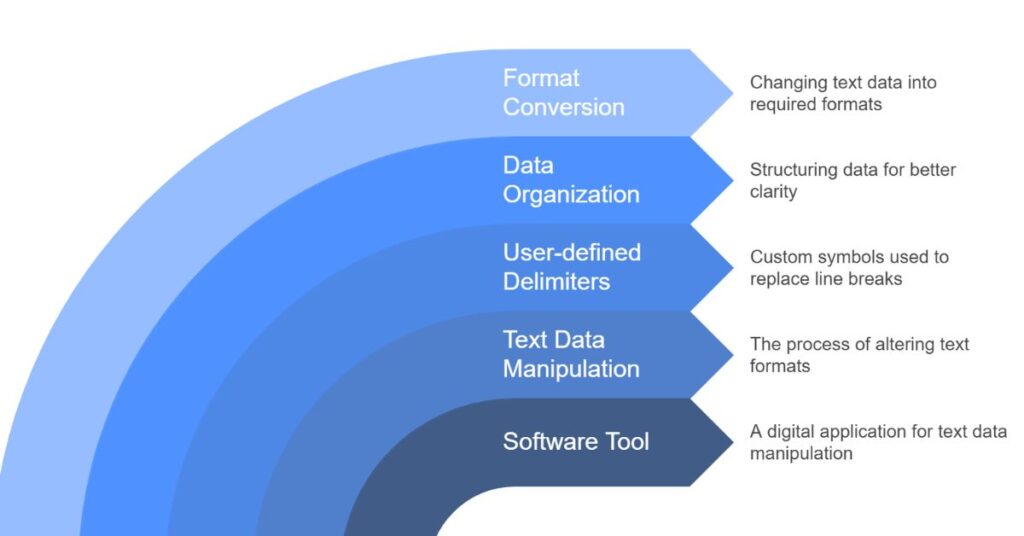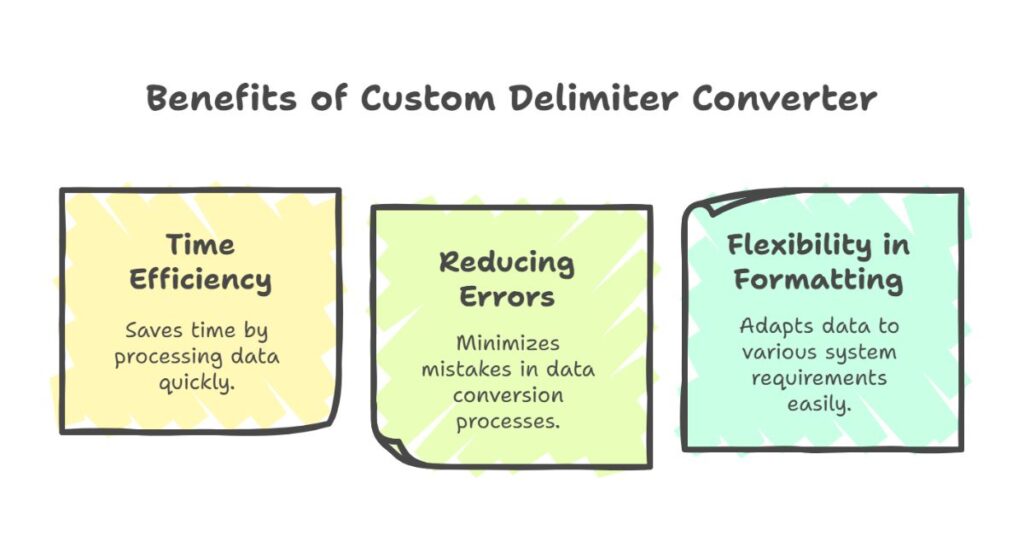Custom Delimiter Converter
Table of Contents
A Custom Delimiter Converter is a tool that simplifies the process of transforming data into different formats. It allows users to convert plain text by replacing line breaks with custom delimiters, such as commas, semicolons, or any other character. This is especially helpful when dealing with large datasets or when preparing data for import into other software.
What is a Custom Delimiter Converter?
A Custom Delimiter Converter is a software or online tool that helps users manipulate text data. It replaces line breaks in a block of text with user-defined delimiters, making the data more organized or easier to import into systems that require specific formats. For example, when converting a list of items in a text document into CSV format, the user can replace line breaks with commas.

Why Use a Custom Delimiter Converter?
Streamlining Data Processing
Many data processing tasks require transforming raw data into a specific format. Whether you are working with spreadsheets, databases, or text-based software, different formats often need different delimiters. A custom delimiter converter allows for easy conversion between different delimiter formats, saving time and effort.
Simplifying Data Import
When importing data into tools like Excel or databases, it is often necessary to use a specific delimiter to separate fields. A custom delimiter converter can easily change the delimiter format to match the system’s requirements. This removes the need for manual editing, which can be time-consuming and prone to error.
Increasing Flexibility
The ability to choose a custom delimiter gives users more control over their data. Unlike standard tools that use commas or tabs, a custom delimiter converter allows users to define any character as a delimiter. This is useful in cases where the standard delimiter conflicts with the content or where the data needs to meet specific formatting requirements.
How Does a Custom Delimiter Converter Work?
Basic Functionality
The basic operation of a custom delimiter converter is straightforward. The user inputs a block of text, specifies the delimiter they want to use, and the tool processes the text by replacing line breaks with the specified delimiter. The result is a new string of text where the lines are separated by the custom delimiter.
Example: Converting Text to CSV Format
Consider a simple text block where each item is on a new line:
Apple
Banana
Cherry
Date
Using a custom delimiter converter, you can replace the line breaks with commas to convert the text into CSV format:
Apple,Banana,Cherry,Date
This allows the data to be easily imported into software like Excel or Google Sheets, where commas are typically used as field separators.
Choosing the Right Delimiter
The choice of delimiter depends on the specific use case. Common delimiters include:
- Comma (,): Often used in CSV files to separate values.
- Tab (\t): Used in TSV (Tab-Separated Values) files.
- Semicolon (;): Sometimes used in CSV files, especially in European countries.
- Pipe (|): Used in some data exchange formats.
- Space ( ): Useful when working with simple text data.
The custom delimiter converter makes it easy to switch between these delimiters or use something unique.
Benefits of Using a Custom Delimiter Converter

Time Efficiency
Manual conversion of data can be time-consuming. A custom delimiter converter can process large datasets in seconds, saving valuable time. The tool can handle multiple lines of text quickly and accurately, allowing users to focus on more important tasks.
Reducing Errors
Manually replacing line breaks with delimiters can lead to errors, especially when working with large amounts of data. A custom delimiter converter eliminates this risk by automating the process. It ensures that the delimiter is placed correctly, avoiding mistakes like missing delimiters or extra spaces.
Flexibility in Data Formatting
Data often needs to be formatted to meet the requirements of different systems. For instance, a database might require fields to be separated by tabs, while an Excel sheet may need commas. A custom delimiter converter allows users to easily switch between these formats without worrying about manually editing the data.
How to Use a Custom Delimiter Converter
Step 1: Input Your Text
Start by copying your text into the input field of the custom delimiter converter tool. This text can be a list of items, a block of data, or any other type of content where line breaks need to be replaced with delimiters.
Step 2: Specify the Delimiter
Next, choose the delimiter you want to use. You can select a predefined option like a comma, semicolon, or tab, or you can enter a custom character if you need something different.
Step 3: Convert the Text
After entering the text and selecting the delimiter, click the “Convert” button. The tool will process the input and replace all line breaks with the specified delimiter. The output will be displayed in the output field.
Step 4: Copy or Paste the Converted Text
Once the text is converted, you can copy it for use in another application or paste it into a different document. Some tools also allow you to directly download the converted text as a file, such as a CSV file.
Real-World Applications of Custom Delimiter Converters
Data Importing
Businesses often use custom delimiter converters to prepare data for import into various software programs. For example, when importing customer data into a CRM system, it may be necessary to convert the data into a format that the system can understand. A custom delimiter converter makes this process seamless.
Text Data Processing
Data analysts and developers frequently work with large datasets that need to be converted into a specific format for analysis or storage. A custom delimiter converter helps automate this process, reducing manual effort and improving efficiency.
Generating Reports
In many reporting tools, data is presented in rows and columns. Using a custom delimiter converter, users can easily prepare data for reports by replacing line breaks with the appropriate delimiter, making the data ready for analysis and presentation.
Conclusion
A custom delimiter converter is an essential tool for anyone working with text-based data. It provides an easy and efficient way to transform data into the desired format, saving time, reducing errors, and increasing flexibility. Whether you’re preparing data for import, processing large datasets, or generating reports, a custom delimiter converter can streamline your workflow and improve your productivity. By offering a straightforward, user-friendly solution, it helps users manage and organize data quickly and effectively.